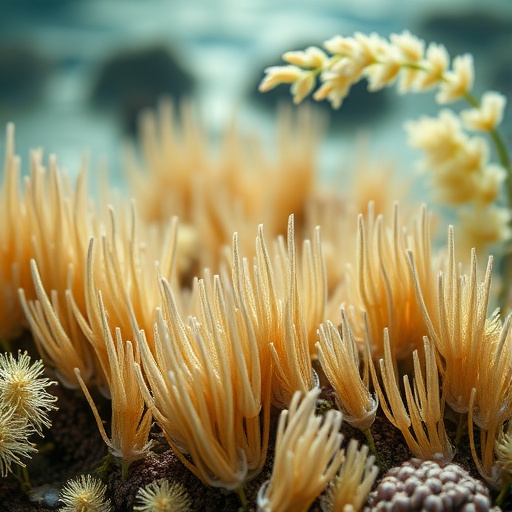In recent years, the escalating challenges posed by climate change have spurred intensive investigations into how rising temperatures influence aquatic ecosystems. A groundbreaking study conducted by Yao, Cao, You, and their colleagues, published in Environmental Earth Sciences, delves deep into the intricate interactions between Ceratophyllum demersum L., a submerged aquatic plant, and Microcystis aeruginosa, a notorious cyanobacterium responsible for harmful algal blooms. Their research sheds light on the complex biological and ecological ramifications of increased temperature on these two species, offering critical insights into future aquatic ecosystem dynamics.
The study examines how elevated water temperatures affect the competitive and symbiotic relationships between C. demersum and M. aeruginosa. Ceratophyllum demersum, commonly known as coontail or hornwort, serves a vital role in freshwater environments by providing habitat, oxygenation, and nutrient cycling. Conversely, Microcystis aeruginosa is infamous for its rapid proliferation under eutrophic conditions, often resulting in toxic blooms detrimental to aquatic life and human health. Understanding how warming influences the balance between these species is crucial for predicting ecosystem stability amid climate perturbations.
Employing finely controlled laboratory experiments and field observations, the research team found that temperature increments notably enhance the growth rate of M. aeruginosa, thereby intensifying its potential to dominate aquatic environments. Elevated temperatures accelerated the cyanobacterium’s photosynthetic efficiency and nutrient uptake, enabling it to outcompete submerged macrophytes like C. demersum under certain thermal thresholds. This shift could destabilize aquatic ecosystems by reducing plant-mediated oxygen generation and habitat complexity.
Interestingly, Ceratophyllum demersum displayed nuanced physiological responses to elevated temperatures. While moderate warming stimulated its metabolic activities and growth, extreme temperature elevations imposed stress, reducing its competitive ability and survival rate. This biphasic response underscores the vulnerability of submerged plants to climate-induced thermal stress and suggests that they may only temporarily counterbalance cyanobacterial dominance before succumbing under persistent warming scenarios.
The authors explored the mechanisms underlying these interactions by analyzing nutrient dynamics, photosynthetic pigments, and oxidative stress markers in both organisms. Microcystis aeruginosa increased its production of microcystins—potent hepatotoxins—under warming conditions, exacerbating its harmful environmental impact. At the same time, C. demersum’s antioxidant defense systems were initially upregulated but eventually overwhelmed as temperatures escalated, leading to cellular damage and impaired physiological functions.
Such findings highlight the multifaceted nature of species interactions under climate stressors. The warming-driven proliferation of M. aeruginosa not only jeopardizes water quality through toxic blooms but also compromises aquatic plant communities that underpin ecosystem services. Consequently, the balance between autotrophic aquatic plants and cyanobacteria is poised to shift unfavorably with ongoing global temperature rises, carrying dire implications for biodiversity and water resource management.
Furthermore, the study evaluated how increased temperature modulates the allelopathic interactions between the two species. Ceratophyllum demersum is known to release bioactive compounds that can inhibit cyanobacterial growth. However, at higher temperatures, the efficacy of these inhibitory compounds diminished, enabling M. aeruginosa to evade suppression and proliferate more aggressively. These thermally modulated chemical interactions emphasize the fragility of natural regulatory mechanisms amidst changing climates.
Such revelations are pivotal for designing mitigation strategies aimed at controlling harmful algal blooms in freshwater systems. The research suggests that traditional biological checks, such as native submerged vegetation management, may become less effective in warmer environments. Therefore, enhanced monitoring coupled with innovative interventions that address both physical and biological factors will be indispensable for managing cyanobacterial outbreaks in a warming world.
Also noteworthy is the potential feedback loop identified: as M. aeruginosa blooms increase with rising temperatures, the resulting shading and nutrient alterations potentially suppress submerged macrophyte growth, further exacerbating cyanobacterial dominance. This positive feedback mechanism could lead to persistent eutrophic states, challenging conventional restoration efforts and amplifying ecological degradation.
The methodology underpinning this research integrated advanced analytical techniques, including chlorophyll fluorescence assays, toxin quantifications, and molecular assessments of stress-related gene expression. Such comprehensive approaches allowed the team to dissect physiological and biochemical alterations at fine scales, providing a robust framework that could be extended to other aquatic species interactions under environmental stress.
In conclusion, the study by Yao and colleagues offers a detailed and compelling narrative on how temperature elevation reshapes the interplay between Ceratophyllum demersum and Microcystis aeruginosa. The findings underscore the urgency of incorporating thermal effects into ecological models and water management policies to anticipate and mitigate the escalating risks posed by cyanobacterial blooms under climate change.
This research advances our understanding of aquatic ecosystem responses to global warming and underlines the complexity inherent in biotic interactions modulated by environmental variables. It calls for interdisciplinary efforts bridging ecology, toxicology, and climate science to safeguard freshwater resources and ecosystem resilience.
As aquatic systems continue to face mounting anthropogenic pressures, elucidating the drivers behind species dominance and decline becomes imperative. The work presented here stands as a seminal contribution that not only informs scientific inquiry but also serves as a wake-up call for proactive environmental stewardship in the face of unprecedented global changes.
The insights derived from this investigation pave the way for further research exploring the synergistic effects of other climate factors such as altered precipitation patterns, increased CO2 levels, and nutrient load fluctuations on aquatic biotic interactions. These dimensions could reveal additional layers of complexity and guide holistic ecosystem management approaches.
Ultimately, the intertwined fate of submerged plants and cyanobacteria under warming scenarios reflects broader ecological principles about species adaptability, resilience, and vulnerability. As climate change unfolds, such case studies will be invaluable in predicting ecological shifts and implementing strategies that preserve biodiversity and ecosystem function.
Subject of Research: Interactions between Ceratophyllum demersum L. and Microcystis aeruginosa under elevated temperature conditions.
Article Title: The interactions between Ceratophyllum demersum L. and Microcystis aeruginosa exposed to increased temperature.
Article References:
Yao, L., Cao, Q., You, B. et al. The interactions between Ceratophyllum demersum L. and Microcystis aeruginosa exposed to increased temperature. Environ Earth Sci 84, 672 (2025). https://doi.org/10.1007/s12665-025-12684-5
Image Credits: AI Generated




